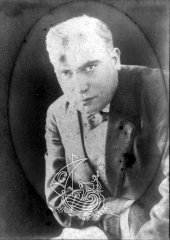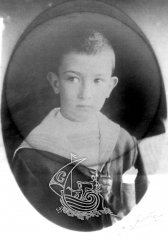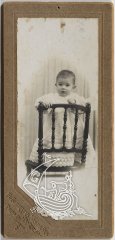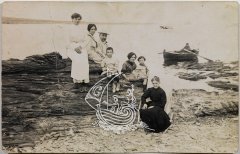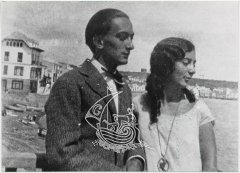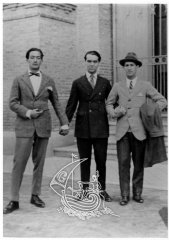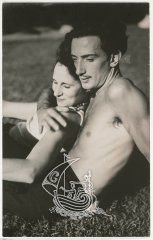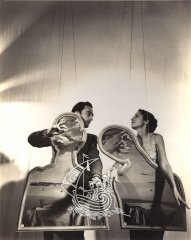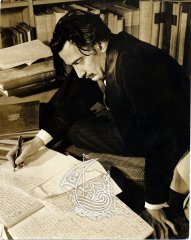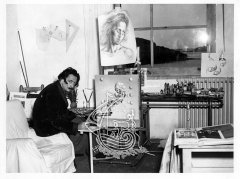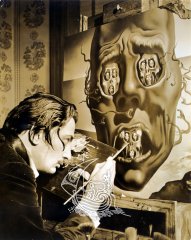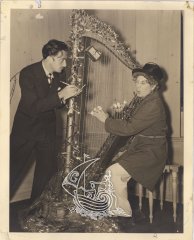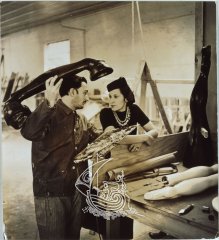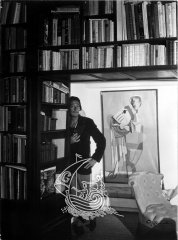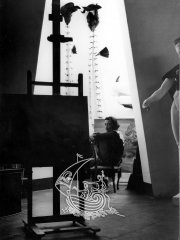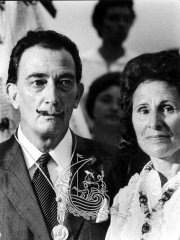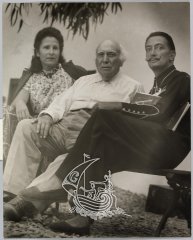Salvador Dalí i Domènech
Figueres, 11 May 1904 - 23 January 1989
1904
Born on 11 May in Figueres (Girona). Son of the notary public Salvador Dalí Cusí and his wife Felipa Domènech Ferrés.
1908
The couple's only daughter, Anna Maria, was born. His father enrolled Salvador at the State Primary School, under the teacher Esteve Trayter.
1910
Two years later, and due to that first option having failed, his father decided to enrol Salvador at the Hispano-French School of the Immaculate Conception in Figueres, where he learned French, the language that was to become his cultural vehicle.
1916
Salvador spent periods on the outskirts of Figueres, at the Molí de la Torre estate owned by the Pichot family, a family of intellectuals and artists; it was there, through the collection owned by the painter Ramon Pichot, that he discovered Impressionism. After a mediocre primary school period, in the autumn he began his secondary schooling at the Marist Brothers' school and at Figueres grammar school. He also attended the classes taught by Juan Núñez at the Municipal Drawing School in Figueres.
1919
Took part in a group exhibition at the Societat de Concerts rooms in Figueres' Municipal Theatre (which was years later to become the Dalí Theatre-Museum). With a group of grammar-school friends he founded Studium magazine, in which he published his first articles. He began a personal diary entitled Les meves impressions i records íntims (My Personal Impressions and Private Memories), which he continued through the following year.
1920
If he were set on becoming a painter, his father made it a condition that he go to Madrid to study at the Fine Arts School, in order to qualify as a teacher. Dalí accepted to do so.
1921
His mother died in February. The following year, his father married Catalina Domènech Ferrés, the deceased woman's sister.
1922
He took part in the Students Original Art Works Competition Exhibition of the Catalan Students' Association, held at Galeries Dalmau in Barcelona, where his work Market was awarded the University Vice-Chancellor's prize. In Madrid, he attended the Special Painting, Sculpture and Engraving School (Real Academia de Bellas Artes de San Fernando) and lived at the Residencia de Estudiantes, where he befriended a group of young people who were also to become with time leading intellectual and artistic personalities: Luis Buñuel, Federico García Lorca, Pedro Garfias, Eugenio Montes and Pepín Bello, among others.
1923
He was expelled from the Academia de San Fernando, accused of having led a student protest against the painter Daniel Vázquez Díaz not having been granted the chair of Painting at the Painting School. He returned to Figueres, where he took up his classes again with Juan Núñez, who instructed him in the technique of etching.
1924
In autumn he returned to the Academia de San Fernando from which he had been expelled, being now obliged to repeat an academic year.
1925
He took part in the First Exhibition of the Iberian Artists Society in Madrid, while at Galeries Dalmau in Barcelona he presented his first individual exhibition. This was his period of rejecting the vanguard and questing for a pictorial tradition, essentially an Italian one. Over this academic year, 1925-1926, he did not return to the Academia de San Fernando. Federico García Lorca spent the holidays with Dalí in Cadaqués.
1926
He participated in several exhibitions in Madrid and Barcelona. In the company of his aunt and his sister, he made his first trip to Paris, where he met Picasso and visited the Louvre Museum. He was expelled for good from the Escuela de Bellas Artes de Madrid for declaring the Tribunal that was to examine him incompetent. He returned once more to Figueres and devoted himself intensely to painting.
1927
He held his second individual exhibition at Galeries Dalmau in Barcelona and took part in the Second Autumn Salon at the city's Sala Parés gallery. The works presented reveal the first clear influences of surrealism. He did his military service at Sant Ferran castle in Figueres. With publication of the article "San Sebastián", devoted to Lorca, there began Dalí's regular and extensive collaboration with the vanguardist journal L'Amic de les Arts, in a relationship that was to continue until 1929.
1928
Along with Lluís Montanyà and Sebastià Gasch he published the Yellow Manifesto (Catalan Anti-Artistic Manifesto) that amounted to a fierce attack on conventional art. He took part in the Third Autumn Salon at Sala Parés and in the Twenty-seventh International Exhibition of Paintings in Pittsburgh, United States.
1929
He travelled again to Paris and, through Joan Miró, came into contact with the group of surrealists headed by André Breton. The film Un chien andalou was shown at Paris' Studio des Ursulines, being the fruit of his collaboration with Luis Buñuel. He spent the summer in Cadaqués, where he received a visit from the gallery-owner Camille Goemans and a friend of his, as well as René Magritte and his wife, Luis Buñuel, Paul Eluard and Gala, and the couple's daughter Cécile. From that time on, Gala was never to leave his side. He took part in the group exhibition Abstrakte und surrealistische Malerei und Plastik at the Kunsthaus in Zurich. His first individual exhibition was held at Galerie Goemans in Paris. This was a year of family break-up.
1930
L'âge d'or (The Age of Gold), the second film he made in collaboration with Buñuel, had its first performance at Studio 28 in Paris. Éditions Surréalistes published his book La femme visible (The Visible Woman), a compilation of articles that had previously appeared in various magazines, such as "The Putrified Donkey", in which he laid the foundations for his paranoiac-critical method. By the beginning of the 'thirties Dalí had found his own style, his private language and the form of expression that was to remain with him thereafter and, while changing and evolving, would be the one we are all familiar with and that so well defines him - a mixture of vanguard and tradition. Behind him lay his first Impressionist canvases and his works influenced, among other movements, by Cubism, purism and futurism. Dalí had become fully integrated into surrealism, and there began his consecration as a painter.
1931
Staged his first individual exhibition at Galerie Pierre Colle in Paris, where he exhibited his work The Persistence of Memory. He also took part in the first surrealist exhibition in the United States, held at the Wadsworth Atheneum in Hartford. His book L'amour et la mémoire (Love and Memory).
1932
He took part in the exhibition Surrealism: Paintings, Drawings and Photographs, organised by the Julien Levy Gallery in New York. His second individual exhibition was held at Galerie Pierre Colle in Paris. His book Babaouo, in which he outlined his conception of cinema. At the end of this year, Dalí announced to the Viscount of Noailles the creation of the Zodiaque Group, a group of friends who joined together to help Salvador Dalí financially by commissioning him to create works that they then purchased on a regular basis.
1933
The first issue of the Paris-based magazine Minotaure published the prologue to the book that remained unpublished until 1963 Interprétation paranoïaque-critique de l'image obsédante "L'Angélus" de Millet (Paranoiac-critical Interpretation of the Obsessive Image The Angelus by Millet). He took part in a collective surrealist exhibition at Galerie Pierre Colle, where he also presented his third individual exhibition. First individual exhibition at the Julien Levy Gallery in New York.
1934
Enters into civil matrimony with Gala (née Elena Ivanovna Diakonova). He exhibited at the Exposition du Cinquantenaire in the Salon des Indépendants of the Grand Palais in Paris, without taking account of the opinion of the rest of the surrealists, who had decided not to participate in it, which nearly led to Dalí being expelled from the group led by Breton. He staged his first individual exhibition at the Zwemmer Gallery in London. Along with Gala he boarded vessel Champlain to make his first journey to the United States. Two individual Dalí exhibitions were held, one at the Julien Levy Gallery and another at the Avery Memorial of the Wadsworth Atheneum, in Hartford (Connecticut).
1935
The couple returned to Europe on board the Normandie. Salvador Dalí went to Figueres in March, where a family reconciliation took place. Éditions Surréalistes published his book La conquête de l'irrationnel (The Conquest of the Irrational).
1936
In May he took part in the Exposition Surréaliste d'Objets at the Galerie Charles Ratton in Paris. In June he took part in the International Surrealist Exhibition held at the New Burlington Galleries in London. On December 14th, Time devoted its cover to him, with photography by Man Ray. He took part in the exhibition Fantastic Art Dada Surrealism at the MOMA in New York. His third individual exhibition was held at the Julien Levy Gallery in New York.
1937
In February he met the Marx Brothers in Hollywood. Along with Harpo, he began work on the script for a film entitled Giraffes on Horseback Salad (but called in its latest version The Surrealist Woman), which was never actually produced. Dalí and Gala returned to Europe. Éditions Surréalistes published his poem "The Metamorphosis of Narcissus", which the gallery-owner Julien Levy also published at the same time in English.
1938
January 17th saw the inauguration at Galerie Beaux-Arts in Paris of the Exposition Internationale du Surréalisme, organised by André Breton and Paul Eluard, with Salvador Dalí's Rainy Taxi exhibited at the entrance to the gallery. In London, Dalí visited Sigmund Freud.
1939
On March he presented his individual exhibition at the Julien Levy Gallery. He designed the Dream of Venus pavilion, which was presented in the World's Fair of New York amusement zone. The Metropolitan Opera House of New York staged the first performance of the ballet Bacchanale, with libretto, costumes and sets by Salvador Dalí and choreography by Léonide Massine. Breton's article "Latest Tendencies in Surrealist Painting" brought about Dalí's expulsion from the surrealist group. In September the couple returned once more to Europe.
1940
When the German troops entered Bordeaux, the Dalí couple went to live in the United States, where they were to remain until 1948.
1941
Dalí's interest in jewellery design began, this being an enthusiasm that was to last throughout his entire artistic career. He began his professional relationship with the photographer Philippe Halsman, which was to continue right up to the latter's death in 1979. He exhibited at the Julien Levy Gallery in New York. On October 8th the Ballets Russes de Montecarlo gave their first performance at the Metropolitan Opera House of Labyrinth, with libretto, decors and costumes by Dalí, choreography by Léonide Massine and music by Schubert. New York's MOMA gallery inaugurated on November 18th an anthological exhibition devoted to Dalí and Miró.
1942
New York's Dial Press published The Secret Life of Salvador Dalí finished the year before.
1943
On Merch 21 , the Reynolds Morse couple purchased their first Dalí painting, this was to be the start of a major collection of works by the painter. In May he designed a new ballet, El Café de Chinitas, based on a true story adapted by Federico García Lorca, which was performed in Detroit and at New York's Metropolitan Opera House.
1944
On October at the International Theatre in New York, Ballet International presented Sentimental Colloquy, with sets designed by Dalí. Dial Press published Dalí's first novel, Hidden Faces. December 15th saw the New York debut by Ballet International of Mad Tristan, the first paranoiac ballet about the eternal legend of love in death. Dalí's plot was based on the musical themes of Wagner's Tristan and Isolda.
1945
He went to Hollywood to work with Alfred Hitchcock on the film Spellbound, whose dreamlike sequences were created by Dalí. The Bignou Gallery inaugurated the exhibition Recent Paintings by Salvador Dalí. This served as the occasion for Dalí to present the first volume of Dali News, which he published himself and which dealt solely with the artist and his oeuvre.
1946
He made the illustrations for various works: The Autobiography of Benvenuto Cellini and Macbeth by Shakespeare, published by Doubleday; The First Part of the Life and Achievements of the Renowned Don Quixote de la Mancha by Miguel de Cervantes, published by Random House of New York. Walt Disney hired Dalí to help produce the film Destino.
1947
Doubleday published the Essays of Michel de Montaigne, selected and illustrated by the painter.
1948
He published 50 Secrets of Magic. The Dalí couple returned to Spain.
1949
The end of the 1940s heralded the onset of his mystical and nuclear period - the corpus of which he set out in his Mystical Manifesto. This was a period characterised by his dealing with religious themes and subjects related with the scientific progress of the times, with a special interest in progress relating to nuclear fusion and fission. The creations of this period reveal how the launch of the atom bomb and its aftermath influenced his creation.
1950
He wrote the articles renowned media such as Vogue and Herald American. He gave a talk on "Why I was Sacrilegious, why I am Mystical" at Barcelona's Ateneu Barcelonès.
1951
He presented in Paris his Mystical Manifesto, as well as works based on it. He gave a talk called "Picasso and I" at Madrid's Teatro María Guerrero.
1952-1953
He wrote various articles for French publications as: Arts, Le Courrier des lettres or Connaissance des Arts.
1954
At the Palazzo Pallavicini in Rome he exhibited his drawings to illustrate Dante's The Divine Comedy. He produced illustrations for various books: La verdadera historia de Lidia de Cadaqués (The True Story of Lídia of Cadaqués) by Eugeni d'Ors and Balada del sabater d'Ordis (Balad of the Cobbler of Ordis) by Carles Fages de Climent, for which Dalí also wrote the epilogue.
1956
He published his treaty on Les cocus du vieil art moderne (The Cuckolded of the Old Modern Art). He also gave a talk in homage to Gaudí at the Güell Park in Barcelona, where he created a work right there before those present.
1958
On August 8th Dalí and Gala were married at the Els Àngels shrine in Sant Martí Vell, near Girona.
1960
He filmed the documentary Chaos and Creation.
1961
The period of gestation of the Dalí Theatre-Museum began this year. In August, his native city paid homage to him.
1963
He published his book Le mythe tragique de "L'Angélus" de Millet (The Tragic Legend of The Angelus by Millet), the manuscript of which remained lost for twenty-two years.
1964
He was awarded the Gran Cruz de Isabel la Católica, the highest Spanish distinction. A great retrospective exhibition was inaugurated in Tokyo, organised by Mainichi Newspapers, and then went on to travel to various Japanese cities. Éditions de La Table Ronde published Journal d'un génie (Diary of a Genius).
1965
The Gallery of Modern Art in New York inaugurated the anthological exhibition Salvador Dali 1910-1965.
1966
Albin Michel of Paris published Dalí's book Lettre ouverte à Salvador Dalí (Open Letter to Salvador Dalí), with thirty-three illustrations by the artist himself. Entretiens avec Salvador Dalí also appeared, being a book of interviews conducted by Alain Bosquet.
1968
He took part in the exhibition Dada-Surrealism and their Heritage held at the Museum of Modern Art in New York. As an outcome of his conversations with Louis Pauwels there appeared the book Les passions selon Dalí (The Passions according to Dalí). The year also saw the publication of Dalí de Draeger, in which the painter collaborated and wrote the prologue.
1969
Dalí purchased Púbol Castle and decorated it for Gala. Over the course of the 1960s and 1970s the painter's interest in science and holography increased, for they offered him new perspectives in his constant quest for mastery of three-dimensional images. Dalí studied and used the potential of the new discoveries, particularly those related with the third dimension. He took an interest in all procedures aimed at offering the viewer an impression of plasticity and space; with the third dimension he aspired to gain access to the fourth, namely, immortality.
1970
He held a press conference at the Gustave Moreau Museum in Paris, in which he announced the creation of the Dalí Theatre-Museum in Figueres. The Museum Boijmans van Beuningen in Rotterdam organised a major retrospective exhibition of his work, which in the following year could be seen at the Staatliche Kunsthalle in Baden-Baden (Germany).
1971
Cleveland (Ohio) inaugurated its Dalí Museum to house the A. Reynolds Morse collection. Under the title Oui, an anthology of articles dating from various periods was published.
1972
The Knoedler Galleries presented the first world exhibition of holograms that Dalí had created in collaboration with Dennis Gabor.
1973
A year before its inauguration, the Dalí Theatre-Museum in Figueres presented the exhibition Dalí. His Art in Jewels. This year also saw the publication of his books Comment on devient Dalí (How One Becomes Dalí), with prologue and notes by André Parinaud, and Les dîners de Gala (Gala's Dinners), published by Draeger. The Louisiana Museum at Humlebeak organised a Dalí retrospective that was later exhibited also at the Moderna Museet of Stockholm.
1974
He wrote the prologue for and illustrated Sigmund Freud's book, Moses and Monotheism. The Dalí Theatre-Museum was inaugurated on September 28th.
1977
The Draeger publishing house issued Les Vins de Gala (Gala's Wines).
1978
He presented at the Solomon R. Guggenheim Museum in New York his first hyperstereoscopic painting, Dalí Lifting the Skin of the Mediterranean to Show Gala the Birth of Venus.
1979
He was appointed associate overseas member of the Académie des Beaux-Arts of the Institut de France. A major Dalí retrospective was inaugurated at the Georges-Pompidou Centre in Paris, as well as the '"environnement" he had specially designed for the centre. By then well into the 1980s he was to paint his last works, basically taking their inspiration from Michelangelo and Raphael, whom he had always admired.
1980
From 14 May to 29 June, London's Tate Gallery presented a retrospective of Salvador Dalí, with a total of two hundred and fifty-one works on show.
1982
The Salvador Dalí Museum, owned by the Reynolds Morse couple, was inaugurated in St. Petersburg (Florida). On 10 June Gala died in Portlligat. Spain's King Juan Carlos I appointed him Marquis of Púbol. Salvador Dalí went to live at Púbol Castle.
1983
A major anthological exhibition, 400 works by Salvador Dalí from 1914 to 1983, was held in Madrid, Barcelona and Figueres. His last pictorial works date from this period.
1984
Following a fire at Púbol Castle, he moved for good to Torre Galatea, Figueres, where he was to remain until his death.
1989
Dalí died in Figueres on 23 January 1989. A major retrospective exhibition Salvador Dalí, 1904-1989 was held at the Staatsgalerie in Stuttgart, and was shown later at the Kunsthaus in Zurich.







